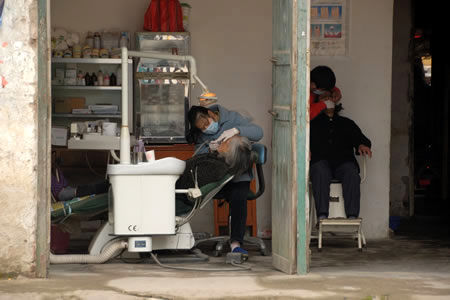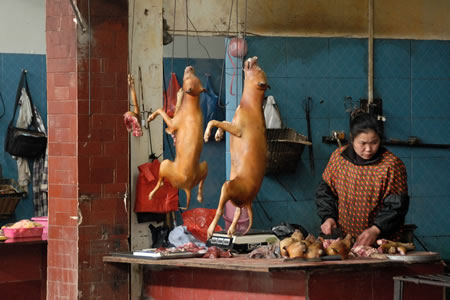English | Dutch |
|
| The end of our first China trip | |
Guăngzhōu (China), February 6th 2010 |
|
We arrived in the southern Chinese metropolis of Guăngzhōu, and that means that our first trip to China’s mainland comes almost to an end. The two months that we spent in this huge country gave us a good image of China. And that image is positive. Of course, there are always positive and negative aspects about a country, but in general we really liked our stay here in China. In this article we will try to describe in short what things mainly constructed the image we have. We travelled in winter time, so we decided to limit our journey to the warmer southern part of the country. We started in Shanghai and travelled via the provinces of Zhèjiāng, Jiāngxī, Húnán, Guìzhōu and Guăngxī to Guăngdōng where we are going to finish our first visit. In a couple of days we cross the border to Hongkong. The impression of a visit to a country is mainly made by the people of that country. Even if the landscape is fantastic, you still will have mixed feelings about the country if the people aren’t very friendly. Before we started our visit to China, we had some mixed feeling about what to expect regarding the Chinese people. This expectation was based on conversations we had with other travellers who visited China before. The general impression we got was that Chinese people can be cold, detached and unmannered. Besides that, we often heard that travelling in China is very difficult because people do not speak English and even won’t try to understand you if you try to make yourself heard. After travelling for two months in China, we must say that this image is undeserved. The Chinese are absolutely not cold and detached, and also the rudeness isn’t that bad. Especially in the big cities and the places where Chinese people celebrate their holidays, people are very welcoming and receptive. They want to know where you are coming from, what your itinerary is, and of course they want to pose on a picture with you. In the rural areas, the situation is slightly different. Because of the lack of English and the fact that people are more reserved, communication is often limited to exchanging a smile or by raisin one’s thumb to show that they appreciate your visit. |
|
 |
|
A dentist in Xīngpíng that you probably want to avoid |
|
Also the rudeness of the Chinese people isn’t that bad. To the contrary, it is already visible in the big cities that the manners of the Chinese people are shifting westwards. They don’t jump the queues that often anymore, spitting on the ground is becoming less and less, rattling of the throat is a rarity, and blowing the nose in the hands is seldom seen these days. However, the further you travel from the main cities, the less they seem to have heard of these new manners. Here you see that it is still the nature of many Chinese to behave themselves without having any sense of shame. In the rural areas they still push in their way in the queues, which means that you really have to fight to get your position at the counter to buy your bus ticket. Also the spitting and rattling is still basic instinct. Don’t be surprised if a young fashionable woman on high heels and with a short sexy skirt, torpedoes green spittle just decimetres from your shoes. Not so sophisticated for a young lady. Also the toilet manners are so so. Children that are not potty-trained yet, wear pants of which the area around their vital parts is open, so that they can do their needs in the public anywhere and anytime. The toilet facilities at the older bus stations and at the stops during a journey, are often still from the middle ages. Cleaning is never heard of, so you need a full bladder and definitely a strong stomach to enter this horrifying area. When you got the guts to get in, you lower your pants and find a place between the train of shitting people, who are squatted above a gutter, with one leg on the left side and the other on the right side. There are no compartments or partitions, which means that you can easily judge if the person in front of you has diarrhoea or not. In that situation, we do the things we have to do as fast as possible to free ourselves of this awkward situation. But not the Chinese; some of them even use this time to make a phone call or send a text message. Travelling with the public transport is straightforward. The train and bus stations are generally well organised and often centrally located. Especially the busses are frequent, making them good alternatives for the trains because of the continuing upgrading of the highways. We don’t like the trains that much because they are less frequent and often arrive/depart at ugly times. Also the purchasing of tickets is easy. We mostly prepare a small note on where we write the name of our destination and the date of travelling. We look up the Chinese name of our destination in our guidebook and copy it in detail on the note. After we gave the note to the lady behind the counter at the bus station, she most of the times turns her computer screen to show us what departure times are available, after which we pick one. The tickets are still only in Chinese, but after some puzzling it isn’t that hard to find out what characters specify the seat numbers and the platform from where the bus departs. And in case of questions, there are many bus station employees who love to take your hand and show you the right bus. | |
 |
|
Slaughtered dogs for sale on the market of Yángshuò |
|
| The sights in China are most of the time beautiful. We visited many places that impressed us. But as often, there is also another side on the medal. The Chinese recognised the tourist market as big business, which means that you nowadays have to pay for almost every sight. And the admission fees are dizzying. A two day admission to a national parks cost you easily twenty-five Euros and also the entrance fee for a ‘simple’ city park with some temples sets you back four or five Euros. And these prices are not only for the ‘rich’ westerners; also the Chinese people pay these inflated prices. And that is not all. At some places they even set up large screens to prevent people getting a glimpse of the sight without paying the admission. The domestic tourism market is really exploding. Because of the increasing welfare of the Chinese, more and more people start travelling. Many of the tourist sights are flooded by loads of people, ripping all the authenticity of the sight. Traditional villages and centuries old towns are transformed into some kind of amusement parks, which are visited by countless tour groups of which the guide is unfortunately armed with a megaphone. But the Chinese people don’t care. They especially enjoy the fact that they are on the way with an enjoyable group of people and that they can pose once in a while for a well thought-out and precisely acted picture. Of course, not without making a peace sign. This behaviour is also seen in the national parks. Also these are literally overrun by noisy tourists, which make it often difficult to fully enjoy the beauty of the place. The only thing you can do is to visit the less visited parts of the parks. That is often not so difficult. Just take a look at the brochure of the national park, and see where the ‘highlighted tourist sights’ are. These are the places where the tour groups go. So if you want to avoid the crowds, avoid these places.
So, China is definitely a great destination. However, the fact that most of the Chinese don’t speak English makes it a tougher destination to travel in as individual traveller; especially if you compare it with other countries in the region. But that’s part of the charm of travelling in this huge and diverse country. The people are in general very pleasant, the public transport efficient, but the hordes of domestic tourists is a concern. The areas that are pointed out by the Chinese tourist authorities as sights are overrun by tourists, which mean that they are often disappointing. The sport of every visit to China is to visit also some places that are not on the tourist trail yet. And that is becoming tougher and tougher. All provinces want to get a part of the ever growing tourist pie, which means that they are very eager to define new tourist sights within their province boundaries. Regularly last months, we visited places where we frowned our eyebrows by seeing the ‘tourist sight’ and the number of tourists it attracted. And we were even lucky to visit them in the off season. We are a little bit concerned about how these places look like in the high season. We will see it when we come back soon. | |